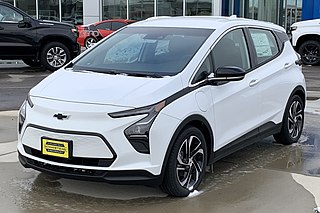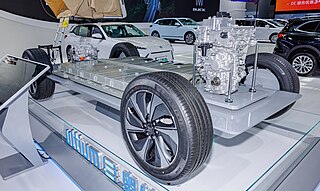A replacement automobile engine is an engine or a major part of one that is sold individually without any other parts required to make a functional car. These engines are produced either as aftermarket parts or as reproductions of an engine that has gone out of production.

The Toyota RAV4 EV is an all-electric version of the popular RAV4 SUV produced by Toyota until 2014. Two generations of the EV model were sold in California, and to fleets elsewhere in the US, with a gap of almost ten years between them.

Crude electric carriages were first invented in the late 1820s and 1830s. Practical, commercially available electric vehicles appeared during the 1890s. An electric vehicle held the vehicular land speed record until around 1900. In the early 20th century, the high cost, low top speed, and short-range of battery electric vehicles, compared to internal combustion engine vehicles, led to a worldwide decline in their use as private motor vehicles. Electric vehicles have continued to be used for loading and freight equipment and for public transport – especially rail vehicles.

The Chevrolet Spark is a city car manufactured by General Motors's subsidiary GM Korea from 1998 to 2022. The vehicle was developed by Daewoo and introduced in 1998 as the Daewoo Matiz. In 2002, General Motors purchased Daewoo Motors, which was marketing the vehicle with several GM marques and nameplates.
Hybrid vehicle drivetrains transmit power to the driving wheels for hybrid vehicles. A hybrid vehicle has multiple forms of motive power.

Chevrolet Performance, formerly "GM Performance Parts", is an automotive performance parts brand that sells everything from camshafts and cylinder heads to high-performance crate engines and upgrades for late-model Chevrolet vehicles. It was founded in 1967 to support the Trans-Am Camaro race teams.

The Chevrolet Volt is a plug-in hybrid car that was manufactured by General Motors, and also marketed in rebadged variants as the Holden Volt in Australia and New Zealand and the Buick Velite 5 in China, and with a different fascia as the Vauxhall Ampera in the United Kingdom and as the Opel Ampera in the remainder of Europe. Volt production ended in February 2019.
Solectria Corporation was responsible for the design, engineering, and manufacturing of energy management components for industrial applications, including electric vehicles, parallel hybrid drivetrains, and power generation applications. It was founded in 1989 and based in Woburn, Massachusetts. In December 2004, Solectria was acquired by Azure Dynamics.

Enova Systems was a United States corporation which designed and supplied battery electric vehicle powertrains and components. The company was founded initially as Clover Solar Corporation on July 30, 1976, in Santa Rosa, California, and changed its name to Solar Electric Engineering in June 1979.

The sixth generation of the Ford F-Series, also known as the "dentside Ford" to enthusiasts, is a line of pickup trucks and medium-duty commercial trucks that were produced by Ford Motor Company from the 1973 to 1979 model years. Produced by Ford in North America, Argentina, and Australia, this is the third and final generation of trucks derived from the 1965 Ford F-Series.

The second generation Chevrolet Volt is a plug-in hybrid electric compact car produced by General Motors under the Chevrolet brand. It debuted at the 2015 North American International Auto Show to replace the original Volt, on sale since 2010. Retail deliveries as a 2016 model year began in October 2015 in the U.S. and Canada, and it was released in Mexico in December 2015. Availability of the 2016 model was limited to California and the other 10 states that follow California's zero emission vehicle regulations. It went on sale as a 2017 model year in the rest of the U.S. in February 2016. Volt production ended on February 15, 2019.

The Chevrolet Bolt EV is a battery electric subcompact hatchback produced by General Motors under the Chevrolet marque. The Bolt was produced from late 2016 to mid-2021, subsequently restarting in early 2022, until late 2023. In mid-2023, GM officials said they would cancel the car, then three months later announced plans but no date for a next-generation model.

The Citroën ë-Berlingo is a battery-electric version of the Berlingo range of car-based light commercial vehicle (LCV) and multi purpose vehicles (MPV) manufactured and sold by Citroën. Rebadged versions are sold by other marques within Stellantis as the Peugeot e-Partner, Opel/Vauxhall Combo-e, and Fiat E-Doblò; in addition, Toyota sells a rebadged version as the Toyota ProAce City Electric.

The GM BEV2 platform is an automotive platform made by General Motors designed specifically for small electric vehicles. Multiple divisions of the LG Corporation have been instrumental in construction in addition to GM's contributions to the platform.
Ioniq is an automotive sub-brand and a division of Hyundai Motor Company with headquarters in Seoul, South Korea. The sub-brand was established in 2020 as a sub-brand for Hyundai's electric vehicle line-up. The sub-brand is slated to aid Hyundai to achieve a targeted one million electric vehicle sales annually by 2025, with the Ioniq brand projected to contribute 560,000 of those sales.

Hyundai E-GMP is a dedicated battery electric vehicle platform for Hyundai Motor Group automobiles. It is the first electric-only dedicated platform by Hyundai. It has been used for Hyundai, Kia, and Genesis automobiles starting in 2021. It follows Hyundai's earlier Power Electric System, which describes the drivetrain of an electric vehicle, including the traction motor, storage battery, and power electronics.

The Renault 5 E-Tech is a B-segment battery electric car by French manufacturer Renault that will begin production in 2024. Inspired by the original Renault 5 in styling, the 5 E-Tech was previewed by a concept car shown in January 2021, with the production model being officially unveiled at the Geneva International Motor Show in February 2024.

Ultium is an electric vehicle battery and motor architecture developed by General Motors. It is being deployed for battery electric vehicles from General Motors portfolio brands along with vehicles from Honda and Acura.

The Opel Manta GSe ElektroMOD is an electric redesign of the Opel Manta, with advanced technology. It has a "pixel visor" and a digital cockpit. Unusual for an electric car, it has a 4-speed manual transmission. Its primary colour is yellow, which is Opel's new corporate colour and this car includes 2 LED ultra-thin headlights. It is a 2-door coupe with two main screens in the interior. A screen has a speedometer, a tachometer and a fuel gauge, but it shows how much charge it has rather than fuel. The other screen is a SatNav.



















